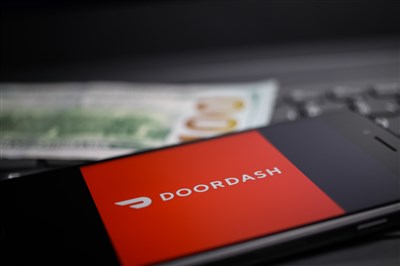
DoorDash (NYSE:DASH), a leading figure in food delivery connecting restaurants and customers, turned in a magnificent earnings report late Thursday that led to 22.1% gains on Friday amid trading volume that was nearly five times normal levels. Some profit-taking appears to have settled in, as the company gave back some of those gains going into trading this morning, but analysts are maintaining an increasingly bullish perspective on the company that seems supported by the latest earnings reports.
DoorDash Earnings Report Features Tremendous Gains
The DoorDash earnings report was a win on several fronts. The company delivered revenue of $1.1 billion for the first quarter of 2020, which was not only up from the fourth quarter of 2020—which featured $970 million in revenue—but also a massive gain from a year prior. The company brought in 198% more in the first quarter of 2021 than in the first quarter of 2020. The consensus expectation for earnings was $993.3 million, which allowed DoorDash to turn in a beat there as well.
Earnings also delivered a beat; the company's earnings before interest, taxes, depreciation and amortization (EBITDA) came in at an adjusted $43 million, which compares magnificently against the first quarter of 2020, when the company posted an adjusted loss of $70 million. However, earnings were not a total win; the DoorDash earnings per share figure turned out to be a loss of $0.34, whereas analysts were expecting a loss of $0.26.
DoorDash also offered insight on several other key points; one of the biggest such insights were gains in DoorDash delivering things that weren't food. The “nonfood delivery segment” featured steady increases and now represents 7% of total gross order value. Moreover, DoorDash expects the nonfood segment to continue growing going forward and improve frequency rates from app users.
Concerns that restaurants being allowed to reopen their dining rooms proved unfounded, as chief financial officer Prabir Adarkar revealed that, not only were negative impacts lower than expected, but the company could beat previously-established guidance by 9%. Adarkar further noted that customers had the opportunity to develop new habits, and with DoorDash offering delivery on items other than food as well, that represented an opportunity to expand those habits and deliver further value therein. The company even went so far as to raise its full year guidance for gross order value from its earlier point of between $30 billion and $33 billion to a new range of between $35 billion and $38 billion.
How Do Financial Analysts Feel About DoorDash Stock?
The DoorDash ticker symbol has represented gains in recent trading, though financial analysts are remaining a bit skeptical, giving the company a consensus “hold” rating that's been in place since February. However, the trend is turning bullish as more “buy” ratings appear on a fairly regular timeline.
Back in February, the company had seven “buy” ratings and 11 “hold” to its credit. In April, the ratios remained comparatively static, with eight “buy” and 12 “hold”. A shift emerged in the latest ratings, however, as the company currently stands at nine “buy” and 12 “hold”. That's still a consensus “hold”, but one that features steadily increasing “buy” interest.
The price target, meanwhile, has a fairly broad range. The current average target is $166.94, with a high of $200 and a low of $135 establishing the average. DoorDash stock is currently trading at $137 as of this writing, so upside potential is fairly clear.
Moreover, recent analyst activity for DoorDash has been increasingly positive. On Friday, three analysts—Truist, Truist Securities, and Wells Fargo & Company—raised both their outlook and their price targets. Mizuho, meanwhile, lowered its price target from its original $170 to $155. A couple of weeks prior, Needham & Company LLC initiated coverage on the company with a “buy” recommendation and a price target of $175. Needham particularly pointed out DoorDash's nonfood growth when it recently reiterated that “buy” rating, suggesting that even with an economy returning to normal, the convenience aspect will remain and continue driving growth.